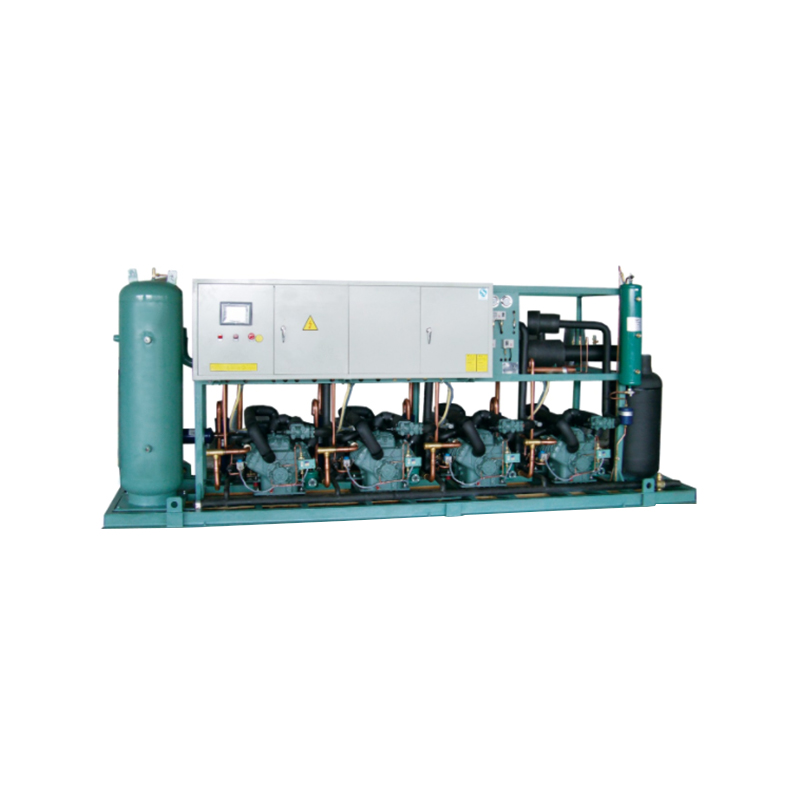How does the parallel condensing unit system judge the change of refrigeration demand and adjust the number of compressors accordingly?
Monitoring of changes in refrigeration demand
The parallel condensing unit system monitors multiple key parameters of the refrigeration system in real time through its advanced intelligent control system to accurately judge the changes in refrigeration demand. These key parameters include but are not limited to:
1. Ambient temperature: The system collects ambient temperature data in real time through temperature sensors installed in appropriate locations. Ambient temperature is one of the important factors affecting refrigeration demand. As the ambient temperature increases or decreases, the refrigeration demand will increase or decrease accordingly.
2. Return air temperature and pressure: The return air temperature and pressure reflect the working status of the evaporator and are important indicators for judging the load changes of the refrigeration system. When the return air temperature increases or the pressure decreases, it usually means that the refrigeration demand increases; conversely, it may indicate a decrease in refrigeration demand.
3. Condensation temperature and pressure: Changes in condensation temperature and pressure also reflect the operating status of the refrigeration system. Although they do not directly determine the refrigeration demand, they can indirectly affect the refrigeration efficiency through the optimization control of the condenser, thereby adapting to changes in refrigeration demand.
4. Refrigeration output: The system directly understands the current refrigeration system's ability to meet load requirements by monitoring the evaporator's refrigeration output. When the cooling capacity output is insufficient, it means that the number of compressors needs to be increased; otherwise, it may need to be reduced.
Adjustment of the number of compressors
After obtaining the above key parameters, the intelligent control system will automatically determine the changes in the cooling demand according to the preset algorithm and logic, and adjust the number of compressors accordingly. The specific process is as follows:
1. Demand analysis: The system first comprehensively evaluates the current cooling demand based on the real-time monitored ambient temperature, return air temperature and pressure, condensing temperature and pressure, and cooling capacity output parameters.
2. Strategy formulation: Based on the results of the demand analysis, the system formulates a corresponding compressor working quantity adjustment strategy. This strategy aims to reduce energy consumption and operating costs as much as possible while meeting the cooling demand.
3. Execution adjustment: After determining the adjustment strategy for the number of compressors, the system realizes the dynamic adjustment of the number of compressors by controlling the start and stop and loading/unloading operations of the compressors. When the cooling demand increases, the system will automatically start more compressors or increase the load of existing compressors; otherwise, it will reduce the number of compressors or reduce their load.
Optimization and improvement
In order to further improve the overall efficiency and flexibility of parallel condensing units, the following optimization measures can also be taken:
1. Frequency conversion regulation: Introducing frequency conversion technology enables the compressor to automatically adjust the speed according to changes in refrigeration demand. This adjustment method is more refined and flexible, and can further improve the energy efficiency ratio.
2. Cascade control: For large parallel condensing unit systems, cascade control can be used to combine multiple compressor units in series or parallel in a certain order. In this way, the number of compressors can be gradually increased or decreased according to different levels of refrigeration demand, achieving more refined load regulation.
3. Intelligent prediction: Use big data and artificial intelligence technology to make intelligent predictions on refrigeration demand. By analyzing historical data and environmental change trends, the number of compressors can be adjusted in advance to cope with possible changes in refrigeration demand in the future.


